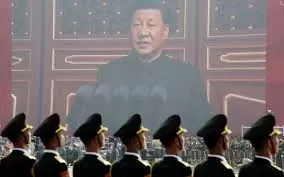China’s Ambitious Military Expansion: Beijing’s New Command Center and Growing Threats
China's military ambitions have been steadily growing in recent years, and a new project near Beijing, dubbed the "Beijing Military City," has raised alarm bells globally. Reports indicate that this facility, once completed, will be up to 10 times larger than the Pentagon,

the U.S. Department of Defense headquarters. Situated approximately 30 km southwest of Beijing, the 1,500-acre site is believed to be designed as China’s primary wartime command center, providing enhanced security, communications, and operational capabilities for the People's Liberation Army (PLA). As tensions continue to rise in the Indo-Pacific region and with the looming threat of Chinese claims over Taiwan, the construction of this massive military complex signals a heightened focus on strategic military preparedness.
The Strategic Importance of the Beijing Military City
Satellite images, reportedly leaked from intelligence sources, have revealed significant construction activity at the site, which began in mid-2024. Experts suggest that the complex will feature reinforced bunkers designed to protect China’s leadership from potential attacks, including those using bunker-buster munitions or even nuclear strikes. This infrastructure reflects China’s growing emphasis on securing its leadership in the event of a military conflict. The development also comes amidst a broader redevelopment in the western part of Beijing, with authorities reportedly demolishing houses and closing off tourist areas, which adds to the secrecy surrounding the project.
The new facility is expected to significantly enhance the PLA's operational capacity. It will likely feature advanced communication systems, enabling the Chinese military to coordinate more effectively and manage its growing array of sophisticated weapons. This site could play a crucial role in coordinating military operations in future conflicts, especially as Beijing's military develops capabilities to challenge adversaries in the Indo-Pacific region, including Taiwan.
A Threat to Taiwan: China’s Ambitions and the 2027 Centenary
The Beijing Military City’s construction occurs against the backdrop of increasing Chinese military assertiveness, particularly in its claims over Taiwan. Chinese President Xi Jinping has set a goal for the PLA to develop full-fledged capabilities to attack Taiwan by 2027, the centenary of the People’s Liberation Army. This is seen as part of a broader strategy to reunify Taiwan with mainland China, a move that has garnered international attention and concern.
In 2024, China significantly ramped up its military pressure on Taiwan, with reports indicating that the PLA carried out more than 3,000 incursions into Taiwan’s airspace. These incursions intensified when Taiwan showed closer ties with the West, particularly the United States, as it sought to bolster its defenses against the growing Chinese threat. Beyond airspace violations, China’s military has demonstrated increasingly sophisticated operations around Taiwan, including drone encirclements and integration of civilian forces to augment military pressure on the self-ruled island.
China’s naval and air maneuvers in the Indo-Pacific have further fueled regional concerns. The expansion of Chinese military activities in the region, including aircraft deployments and naval exercises, has increasingly infringed on the exclusive economic zones (EEZs) of countries such as Japan, South Korea, Vietnam, and the Philippines. This assertive military posture has raised alarm among these nations, which are concerned about China’s growing influence and its ability to control vital sea routes and resources in the region.
The PLA’s Weaknesses and the Need for Integration
Despite China’s growing military capabilities, experts note that one of the key weaknesses of the PLA is its lack of integration and coordination compared to the U.S. military. For China to fully assert its dominance in the region, military experts suggest that Beijing must address the integration of its forces, ensuring that its air, land, and naval capabilities can work seamlessly together.
The construction of a massive wartime command center, such as the Beijing Military City, could be China’s answer to this challenge. By centralizing command and enhancing the ability to respond to multiple threats simultaneously, Beijing aims to ensure that its military can operate effectively in a wide range of scenarios. This project may pave the way for more cohesive and synchronized military operations, enabling China to pursue its expansionist ambitions with greater efficiency and power.
Should the World Be Alarmed?
The construction of the Beijing Military City and China’s increasingly assertive military actions raise critical questions about the future of regional security in the Indo-Pacific. For countries like India, Japan, and the United States, China’s growing military capabilities pose a significant challenge. Beijing’s intentions regarding Taiwan, its frequent incursions into disputed territories, and its strategic partnerships with countries like Russia all point to a more aggressive foreign policy.
Military analysts suggest that China’s actions in Taiwan and the broader Indo-Pacific region should not be viewed in isolation. The Beijing Military City is not just a defensive project; it is part of a broader strategy aimed at projecting power and expanding influence across Asia and beyond. The ability to wage a sustained conflict, especially over Taiwan, would require a level of operational coordination and strategic foresight that this new command center may help facilitate.
Global Implications: The Indo-Pacific at a Crossroads
The construction of a facility like Beijing Military City comes at a critical juncture, as tensions in the Indo-Pacific region continue to rise. For the U.S. and its allies, the growing Chinese threat poses serious geopolitical risks, particularly with regard to Taiwan, a key player in the global technology and semiconductor industries. The increasing military presence of China in contested waters, coupled with its expansive claims over Taiwan, could destabilize the region and potentially lead to conflict.
For India, which shares a border with China, the implications are even more direct. The ongoing border standoff with China, particularly in the Ladakh region, highlights the vulnerability of countries that share borders with the rising superpower. While India has significantly modernized its military in recent years, the Chinese threat remains a concern, especially as Beijing continues to bolster its military infrastructure and capabilities.
The Way Forward: Vigilance and Preparedness
As China continues to build its military capacity and expand its influence, the world must remain vigilant. The development of the Beijing Military City signals China’s determination to enhance its military readiness, not just for regional dominance but also for potential global power projection. The facility could give China a significant strategic advantage in any future conflict, particularly in Taiwan, and may reshape the security landscape in the Indo-Pacific.
For countries in the region, including India, Japan, and the United States, the growing Chinese military threat demands greater cooperation and coordination. Strengthening defense alliances, enhancing military integration, and bolstering intelligence-sharing will be critical in countering China’s ambitions. The global community must remain watchful of Beijing’s actions, particularly as it continues to ramp up its military infrastructure and prepares for future conflict in the Indo-Pacific region.
Conclusion: The Future of the Indo-Pacific
China’s expansionist military agenda and the construction of the Beijing Military City reflect the nation’s growing ambitions to assert control over Taiwan and the broader Indo-Pacific region. As the PLA prepares for potential conflict, the international community must respond with vigilance and preparedness. Whether through diplomatic engagement, military deterrence, or strategic partnerships, the world must ensure that China’s military power does not destabilize the region and threaten global peace. The next few years will be critical in determining the balance of power in the Indo-Pacific, with China’s military developments playing a pivotal role in shaping the future of global security.
What's Your Reaction?















